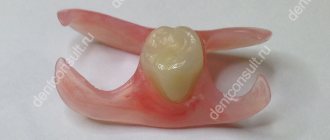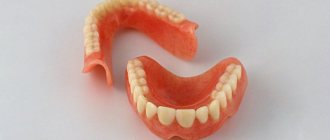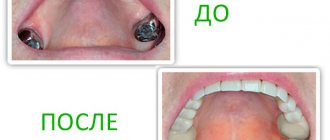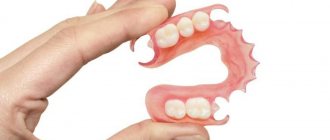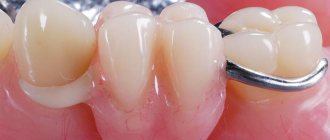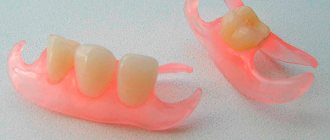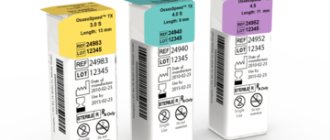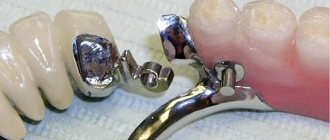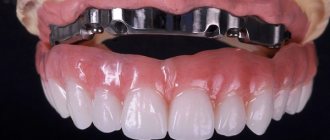Types of partial dentures
Partial removable plates
An ideal solution for restoring chewing teeth, as well as in the presence of dentition defects (several teeth in a row). This type of prosthetics involves the use of a special plate with artificial teeth, attached to the patient’s remaining teeth. The use of such prostheses is most beneficial in terms of price and ease of use.
In the photo: partial removable lamellar denture
Compared to full-type models, partial plate dentures are smaller in size and easier to install. And in some cases, they can be used even with included (limited by natural teeth on both sides) defects.
Immediate dentures
They are used as a temporary structure applied to the surface of the jaw immediately after tooth extraction, as well as at the preparatory stage for the installation of a permanent prosthesis.
Dental segments or removable sectors
They are classified as one-sided prostheses, i.e. are used to restore a row of chewing teeth on one side of the jaw.
Partial clasp systems
Comfortable, durable and reliable design with many advantages. Compared to other types of orthodontic devices, clasp dentures include a special metal frame in the shape of an arc, which helps distribute the load not only on the supporting teeth, but also on the entire jaw as a whole. They also eliminate the need for mandatory removal of the structure at night. In addition, partial removable dentures made of nylon clasp type without metal inclusion have appeared on the dental market relatively recently. They immediately gained great popularity, because their installation does not require grinding of the supporting teeth, and thanks to the elastic properties and special clasps, the fixation of partial dentures has become very simple and reliable.
Combined
Combined dentures are suitable for both partial and complete loss of teeth. For example, such products include high-tech removable dentures Akri Free, produced on the basis of acrylic polymers. They are very comfortable, reliable and protected from deformation. And if the patient wishes, they can be made with imported teeth, providing even greater comfort and high aesthetics.
Advantages:
- high reliability;
- a variety of fastening methods (using clasps or attachments);
- versatility of use;
- wide selection of components (base and artificial teeth).
Recommendations for caring for removable dentures
A detailed consultation on the care of removable dentures is given by the doctor after completing all the medical procedures that were required for the successful restoration of lost teeth. The advice of a specialist must be followed exactly: this will facilitate the process of adaptation to the prosthesis and will extend its useful life. In particular, the patient must:
- Regularly clean the product with a regular toothbrush, but without using pastes with abrasive particles;
- After eating, rinse the denture with clean water and disinfect it with special solutions;
- Store the product in a special container;
- Use hygiene products for removable dentures.
You should also regularly visit the orthodontist to check for possible deformation changes in the design of the prosthesis and to have the structure professionally cleaned.
Partial dentures: advantages and disadvantages
Pros:
- installation possible without preparation of adjacent teeth;
- if necessary, additional teeth can be installed on them;
- partial dentures are easy to care for;
- are able to provide a good aesthetic effect;
- are an ideal solution for the treatment of secondary adentia, and also have a relatively affordable price.
Minuses:
- Weak fixation . A common cause of dissatisfaction among patients with partial dentures is their accidental slipping out of the mouth when speaking or in other situations. This problem can be solved using various adhesive materials and creams. However, this approach will only give a temporary effect.
- Alveolar process atrophy . Due to the fact that chewing pressure when using partial dentures is transmitted directly to the mucous membrane of the alveolar process, there is a high risk of its atrophy. And the narrowing of blood vessels observed in this case reduces the outflow of blood and contributes to the development of edema of the mucous membrane as a whole.
- Greenhouse effect . The low thermal conductivity of partially removable dentures made of nylon and acrylic (with a base of these materials) causes a temperature difference between the area under and around the denture. And in combination with the porosity of these materials and the accumulation of food debris in them, the greenhouse effect can cause inflammation of the mucous membranes and bad breath.
Flexible partial denture made from Perflex materials
Nylon partial removable dentures made from materials from the Israeli company Perflex are the most durable and high-quality. Perflex nylon partial dentures are lightweight and moderately flexible. They can be an excellent alternative to metal wire dentures.
Strong fixation to the gum, due to the plasticity of nylon, does not require the use of additional fixative gels. The transparency of the material allows you to create a fairly thin base, which is as similar as possible to the gum. Clasps are also made of nylon.
For partial removable dentures made of Perflex thermoplastic materials:
- hypoallergenic, aesthetic;
- the ability to add a tooth to a denture;
- quick adaptation to the prosthesis;
- comfortable to wear;
- the color of the crowns and base does not change
- gentle contact with the enamel of supporting teeth.
Nylon constructions do not interfere with diction and allow you to chew even hard food comfortably. Indicated for patients with diseases of the temporomandibular joint. You can choose any material for crowns in a nylon prosthesis; even ceramic crowns are used. In our clinic we can carry out orthodontic cleaning of partially removable nylon dentures.
The installation of dentures will take place in several stages. The orthopedist takes an impression and makes a preliminary model of the prosthesis. Then the dentist will press the nylon product and all that remains is the fitting. If the prosthesis requires adjustment, the doctor will correct the design free of charge after fitting. The cost of a nylon product made from Perflex materials is 47,150 rubles.
Indications and contraindications for use
Partial dental prosthetics has the following indications:
- Loss of several or more teeth: end defects of one and two-sided types, included defects of the anterior and posterior groups of teeth.
- Complete loss of dentition on the lower and upper jaw.
- Insufficient number of supporting teeth for the use of clasp and bridge dentures.
- The patient has serious contraindications to implantation.
There are no contraindications for the installation of partial removable dentures on the upper and lower jaw. The choice in favor of another prosthetic technique can be made based on the individual characteristics of the patient.
Pictured: partial denture
Prices for prosthetics with removable dentures
The price of prosthetics with removable dentures will mainly depend on the type of design and method of restoration of lost teeth. Prosthetics with implants and clasp dentures have the highest cost. The most budget option is the use of acrylic and nylon products.
What type of removable denture is best for you? The specialists of our dental clinic in St. Petersburg, Uni-Dent, can help you find a reliable and useful answer to this question. Prosthetics is one of the key activities of our dentistry and we are pleased to offer our patients high quality services, materials from leading manufacturers, innovative equipment and an individual approach to each case!
Manufacturing stages
On average, the production of a partial removable laminar denture and other types takes 2-4 weeks and consists of the following steps:
- The specialist diagnoses the patient, eliminates various diseases of the oral cavity and takes impressions of the jaws.
- In the dental laboratory, an individual “spoon” is created, which is then used by the doctor to create high-precision impressions.
- A wax blank is made based on the impression.
- The required parameters are calculated and fitted. Then the workpiece is sent back to the laboratory, where a full-fledged prosthesis is produced.
- The finished product is tried on and handed over to the patient for permanent use.
Description of partial dentures
The lightness and strength of the materials from which the prostheses are made have been proven. For their production, not only modern technologies are used, but also high-quality, durable raw materials. Manufacturing also has other advantages, such as the lightness of the product and reasonable price range. Compliance with price-quality standards makes the product extremely popular among customers. The alveolar ridge serves as the basis for unlocking the plate. Using special techniques, specialists attach artificial teeth directly to the plate itself. Locks and clasps are also used for this. To prevent future inconveniences, you should pay attention to the sources used in your work. So, if the quality of the product is not high, then the prosthesis may begin to rub the palate or gums, fit poorly or cause discomfort, and come off.
Partial removable dentures in children
In childhood, it is preferable to install the Butterfly immediate prosthesis. This choice is primarily due to the fact that this product, unlike rigid acrylic structures (plate) and models with a metal base (clasp), is made of nylon and completely eliminates the risk of developing allergies, as well as damage to poorly formed gums. Another advantage of this particular type of partial denture is the ability to install it on one tooth, without grinding down healthy teeth, which is very important when restoring chewing function in children.
What is a removable plate partial denture?
The design is based on a plate with simulated teeth on it. Imitation of the gum part can be made of acrylic or nylon. In the latter case, the product is distinguished by its flexibility and natural appearance. The design is made in a variable form, which depends on the number of missing elements.
To fix the dentures, there is no need to grind down adjacent crowns. Partial structures are attached as follows:
- metal clasps
- small hooks starting at the base of the prosthesis and encircling the cervical area of the supporting element. They are used extremely rarely: hooks injure the enamel; - attachments
- miniature locks fixed on the product and supporting units; - metal-free clasps
- modern hooks made of plastic. The elements prevent damage to tooth enamel and have an aesthetic appearance.
Cream Corega
The use of this cream allows you to securely fix the prosthesis on the surface of the gums, as well as fill all the free spaces remaining during normal use. This makes it impossible for food to get under the structure, which protects the gums from serious damage. In addition, as patients note, the use of Corega cream significantly reduces the intensity of chafing and irritation of the gums.
- Mode of application . A certain amount of cream is applied in a thin layer or spotwise to a dry and clean denture. In this case, the cream should be distributed so that it is not close to the edge of the prosthesis. Next, you need to install the device in the oral cavity, press firmly and hold it in this position for several seconds. It is necessary to remove the remaining cream from the denture and gums with a clean cloth lightly moistened with oil.
- Side effects . In rare cases, increased salivation, imbalance of taste sensations and nausea may occur. The development of local allergic phenomena is extremely rare.
- Contraindications . Increased level of sensitivity to the components of the cream.
Differences between fixation on the upper and lower jaw
Partial dentures are fixed to the gums using a base, as well as to supporting teeth using hooks. The device looks like a plastic arch with artificial crowns. The main difference is in the design of the palatal bridge.
The dentures for the top row are equipped with an artificial plastic palate (solid plate). The element increases the area of contact surfaces, thereby improving fixation. The devices are bulky, making it more difficult for patients to get used to them. But in the new generation of prostheses, this element is made in the form of a ring or arc, which makes the design easier.
On the lower jaw the bridge is narrow due to the frenulum of the tongue. The contact area is small, but this reduces the quality of fixation.
